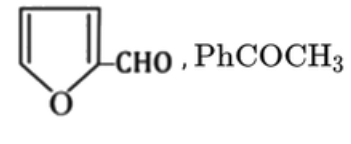A : In crossed Cannizzaro's reaction in between HCHO and C6H5CHO, HCHO is oxidised.
R : OH− firstly attacks on HCHO. So, HCHO is oxidised.
If both Assertion & Reason are true and the reason is the correct explanation of the assertion, then mark (1).
If both Assertion & Reason are true but the reason is not the correct explanation of the assertion, then mark (2).
If Assertion is true statement but Reason is false, then mark (3).
If both Assertion and Reason are false statements, then mark (4).
The correct Answer is:A
To solve the question regarding the crossed Cannizzaro reaction between formaldehyde (HCHO) and benzaldehyde (C₆H₅CHO), we will analyze the assertion and reason provided.
1. Understanding the Cannizzaro Reaction:
- The Cannizzaro reaction is a redox reaction that occurs in aldehydes without alpha-hydrogens in the presence of a strong base (like NaOH). In this reaction, one aldehyde molecule is oxidized to a carboxylic acid, while another is reduced to an alcohol.
2. Identifying the Aldehydes:
- In this case, we have two aldehydes: formaldehyde (HCHO) and benzaldehyde (C₆H₅CHO). Notably, formaldehyde has no alpha-hydrogens, making it suitable for the Cannizzaro reaction.
3. Role of OH⁻:
- The hydroxide ion (OH⁻) acts as a nucleophile and can attack the carbonyl carbon of the aldehydes. The electrophilicity of the carbonyl carbon determines where the attack will occur.
4. Electrophilicity of Aldehydes:
- Benzaldehyde has a phenyl group that can stabilize the carbonyl carbon through resonance (due to the +R effect), which decreases its electrophilicity. Consequently, OH⁻ is more likely to attack the more electrophilic carbonyl carbon of formaldehyde.
5. Mechanism of the Reaction:
- The OH⁻ ion attacks the carbonyl carbon of formaldehyde (HCHO), resulting in the formation of a tetrahedral intermediate.
- This intermediate collapses, leading to the formation of formic acid (HCOOH) and a hydride ion (H⁻).
- The hydride ion then attacks the carbonyl carbon of benzaldehyde (C₆H₅CHO), reducing it to benzyl alcohol (C₆H₅CH₂OH).
6. Conclusion:
- In this reaction, formaldehyde (HCHO) is oxidized to formic acid (HCOOH), while benzaldehyde (C₆H₅CHO) is reduced to benzyl alcohol (C₆H₅CH₂OH).
- Therefore, the assertion that "HCHO is oxidized" is true, and the reason that "OH⁻ firstly attacks HCHO" is also true and correctly explains the assertion.
Final Answer:
Both the assertion and reason are correct, and the reason correctly explains the assertion.
- The Cannizzaro reaction is a redox reaction that occurs in aldehydes without alpha-hydrogens in the presence of a strong base (like NaOH). In this reaction, one aldehyde molecule is oxidized to a carboxylic acid, while another is reduced to an alcohol.
- In this case, we have two aldehydes: formaldehyde (HCHO) and benzaldehyde (C₆H₅CHO). Notably, formaldehyde has no alpha-hydrogens, making it suitable for the Cannizzaro reaction.
- The hydroxide ion (OH⁻) acts as a nucleophile and can attack the carbonyl carbon of the aldehydes. The electrophilicity of the carbonyl carbon determines where the attack will occur.
- Benzaldehyde has a phenyl group that can stabilize the carbonyl carbon through resonance (due to the +R effect), which decreases its electrophilicity. Consequently, OH⁻ is more likely to attack the more electrophilic carbonyl carbon of formaldehyde.
- The OH⁻ ion attacks the carbonyl carbon of formaldehyde (HCHO), resulting in the formation of a tetrahedral intermediate.
- This intermediate collapses, leading to the formation of formic acid (HCOOH) and a hydride ion (H⁻).
- The hydride ion then attacks the carbonyl carbon of benzaldehyde (C₆H₅CHO), reducing it to benzyl alcohol (C₆H₅CH₂OH).
- In this reaction, formaldehyde (HCHO) is oxidized to formic acid (HCOOH), while benzaldehyde (C₆H₅CHO) is reduced to benzyl alcohol (C₆H₅CH₂OH).
- Therefore, the assertion that "HCHO is oxidized" is true, and the reason that "OH⁻ firstly attacks HCHO" is also true and correctly explains the assertion.
Both the assertion and reason are correct, and the reason correctly explains the assertion.
Similar Questions
Aldehydes undergo disproportionation reaction in presence of aqueous NaOH. Simultaneou oxidation and reduction of a compound is scientifically called as disproportionation.
Aldehydes having no α-hydrogen show this rection called Cannizzaro's reaction. Few exception are also there to this represented as :
C6H5CHO+C6H5CHONaOH−−−→ΔC6H5COONa+C6H5CH2OH
Intramolecular Cannizzaro's reaction is also possible.

Answer the following questions :
The aldehyde which shows Cannizzaro's reaction is :
View SolutionC6H5OHandC6H5COOH show difference in the reaction with
View Solution(X) is the product of cross aldol condensation between benzaldehyde (C6H5CHO) and acetone. What is its structure ?
View Solution1−Phenyl ethanol can be prepared by the reaction of C6H5CHO with :
View SolutionC6H5CH2CH2CH3 is when oxidised in the presence of alk. KMnO4 the product obtained is
View SolutionArrange the following in increasing order of reactivity :
HCHO,CH3CHO AND C6H5CHO
View SolutionArrange the following in increasing order of reactivity :
HCHO,CH3CHO AND C6H5CHO
View SolutionArrange the following in increasing order of reactivity :
HCHO,CH3CHO AND C6H5CHO
View SolutionHow many of these compounds can undergo cannizzaro reaction here
CH3CHO,CH3COCH3,HCHO,Ph−CHO,Ph−CO−CHO, , PhCOCH3
, PhCOCH3
View SolutionAn organic compound (A) (C5H7OCl) reacts rapidly with ethanol to give (B) (C7H12O2). (A) also reacts with water to produce an acid which reacts with bromine to give (C ) (C5H8Br2O2). (B) on boiling with H2SO4 forms an acid (D). When (D) is oxidised with KMnO4 an acid (E ) (C4H6O3) is produced. On mild heating, (E ) gives (F) (C3H6O) which cannot be oxidised by ammoniacal AgNO3. Identify the compounds (A) to (F).
View Solution
